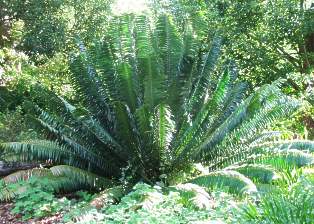Encephalartos paucidentatus
Encephalartos paucidentatus Stapf & Burtt Davy
Family: Zamiaceae
Common names: Barberton cycad
SA Tree No: 11
Introduction
The graceful crown of dark green glossy leaves, vigorous growth and strong stem of Encephalartos paucidentatus makes this one of the most striking of all cycads. Regarded as one of the most handsome species for cultivation, it is unfortunately often illegally harvested in the wild.

Description
Description
The stems of Encephalartos paucidentatus are either upright or procumbent and reach a height of 6 m with a diameter of 0.4-0.6 m. Occasionally they branch from the base. The dark, glossy green leaves are 1.5 to 2.5 m. New leaves are covered with a dense layer of brownish hairs which gradually disappear as the leaves mature. The leaf stalks are straight and yellow with the leaf crown being graceful and spreading. It is a forest species growing in semi-shade on rocky slopes.

It is one of the faster growing species of cycad and under ideal conditions survives for many generations. The male plants produce up to 5 tall, slender, yellow cones, 400-600 x 120-150 mm, covered with brown hairs. They are supported by a 100 mm peduncle (stem). The pollen is released in early winter. Female plants produce 1-5 golden cones, 350-500 x 200-250 mm, supported by a short, sturdy peduncle.
Conservation Status
Status
In its natural habitat, Encephalartos paucidentatus has been considerably reduced and can now be regarded as an endangered species. All South African cycads are Cites listed plants.
Distribution and habitat
Distribution description
This species occurs in the mountains of eastern Mpumalanga in a restricted area near Barberton as well as in the adjacent mountains in the Piggs Peak District of north-western Swaziland. Plants occur at an altitude of up to 1800 m with a rainfall of 1250-1500 mm a year. Conditions are cool and moist with plants occurring in low forest on steep and rocky slopes. Ideal conditions for the cultivation of the Barberton cycad are light shade and ample moisture in a frost-free area.
Derivation of name and historical aspects
History
The specific name is from the Latin paucus, which means few, and dentatus meaning toothed, in reference to the few teeth which appear on the leaflets of the specimens studied when this species was described. There has been confusion about who discovered this plant. Dr R.A. Dyer (1965) came to the conclusion that it was likely that George Thorncroft of Barberton and Reverend Rogers were responsible for the discovery of the Barberton cycad as they were instrumental in sending a specimen to The Royal Botanic Gardens, Kew and alerting the botanists to its existence. At the time, Thorncroft was in regular correspondence with the botanists Burtt Davy and Pole Evans.
Ecology
Ecology
All cycads, as far as we know, are wind- and insect-pollinated. When cycads cone, the presence and activity of snout beetles increases dramatically. It is therefore assumed that they act as a pollinating agent.
Uses
Use
The Barberton cycad is very much sought-after as one of the most striking cycads in a garden, provided it is given sufficient space to develop. The spread of the leaves of a mature plant is approximately 5 m.
Growing Encephalartos paucidentatus
Grow
Encephalartos paucidentatus is a shade-loving species but can also be grown in full sun. This species develops to its full potential in light shade, moist conditions, good drainage in a frost-free situation, with space to grow. This species is one of the faster growing cycads. Once the stem has attained its maximum diameter, the stem height, under ideal conditions, increases by 30-50 mm a year. The spread of its leaves can extend to 5 m and a mature plant can grow to a height of 6 m.
When planting a young plant, it is important to consider all the above factors because once established, E. paucidentatus does not like to be moved. Cynthia Giddy (1978) suggests that as many roots as possible must be retained when moving a plant as they are difficult to re-establish. Grown in full sun, this species develops into a most attractive specimen plant but the leaves tend to be slightly shorter than when grown in shade.

In shade, Clivia, Crinum, Scadoxus multiflorus subsp. Katharinae, Plectranthus, Veltheimia and Asparagus make ideal companion plants for Encephalartos paucidentatus.
Cycads require regular watering and feeding to maintain a healthy plant. A 50-mm thick layer of mulch using well-matured compost applied in the autumn helps to improve the soil and benefits the cycads. In early spring, apply two generous handfuls per plant of a mixture of bone meal, organic fertilizer and a balanced inorganic fertilizer. The use of high-pressure irrigation systems, which produce a strong jet of water, is to be avoided as it will destroy the leaves and stem of the plant.
References
- Donaldson, J. & Winter, J. 1998. Grow cycads. Kirstenbosch Gardening Series. National Botanical Institute, Cape Town.
- Giddy, C. 1978. Cycads of South Africa. Purnell, Cape Town.
- Goode, D.1989. Cycads of Africa. Struik, Cape Town.
- Osborne, R. 1991. Encephalartos paucidentatus. Encephalartos 27: 3-9.
Credits
John Winter
Kirstenbosch Botanic Garden
July 2006
Plant Attributes:
Plant Type: Shrub, Tree
SA Distribution: Limpopo, Mpumalanga
Soil type:
Flowering season:
PH:
Flower colour:
Aspect: Full Sun, Shade, Morning Sun (Semi Shade), Afternoon Sun (Semi Shade)
Gardening skill: Average
Special Features:
Horticultural zones









Rate this article
Article well written and informative
Rate this plant
Is this an interesting plant?
Login to add your Comment
Back to topNot registered yet? Click here to register.